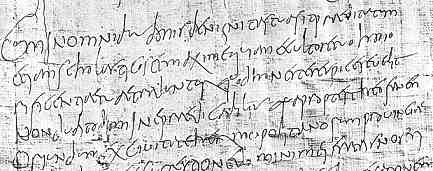Script Type : cursive minuscule
Date : gradually developed from the earlier Old Roman cursive around the beginning of the 4th century and evolved into the minuscule book hands of the 7th and 8th centuries
Location : Christian western Europe
Function : Document hand

This represents a form of personal handwriting in New Roman cursive.






















Distinctive letters : The informally written nature of this example means that there is some variation in the forms of individual letters and some are almost minimalistic in their execution. The letter a is a simple loop open at the top. b appears to be back to front as the bow is on the left. The letters u and v are identical and consist of a particularly insignificant little bent line. Certain letters show the particular forms that would become features of the early medieval book scripts, such as the raised e, long s and open g with no closed loops. There are two forms of n, this particular hand retaining a majuscule N in most cases.
There are no visible examples of j, k, z or, of course, w.
Some letters are joined in truly cursive form, with the tendency for certain letter combinations to form ligatures, as in
![]() etiam or
etiam or
![]() respicere.
respicere.
The script rolls merrily along without any obvious punctuation or separation of words, which all adds to the difficulty of reading it. There are no abbreviations. While it is a script designed for rapid writing, it makes you wonder just how fast they could read it. Pass the cursor slowly along the first couple of lines for a brief introduction. The transcription is from Dr Steffens, as it beats me! As this is included purely for its historic interest as a precursor to the medieval minuscule scripts, there is no paleography exercise for this example.
If you are looking at this page without frames, there is more information about medieval writing to be found by going to the home page (framed) or the site map (no frames).